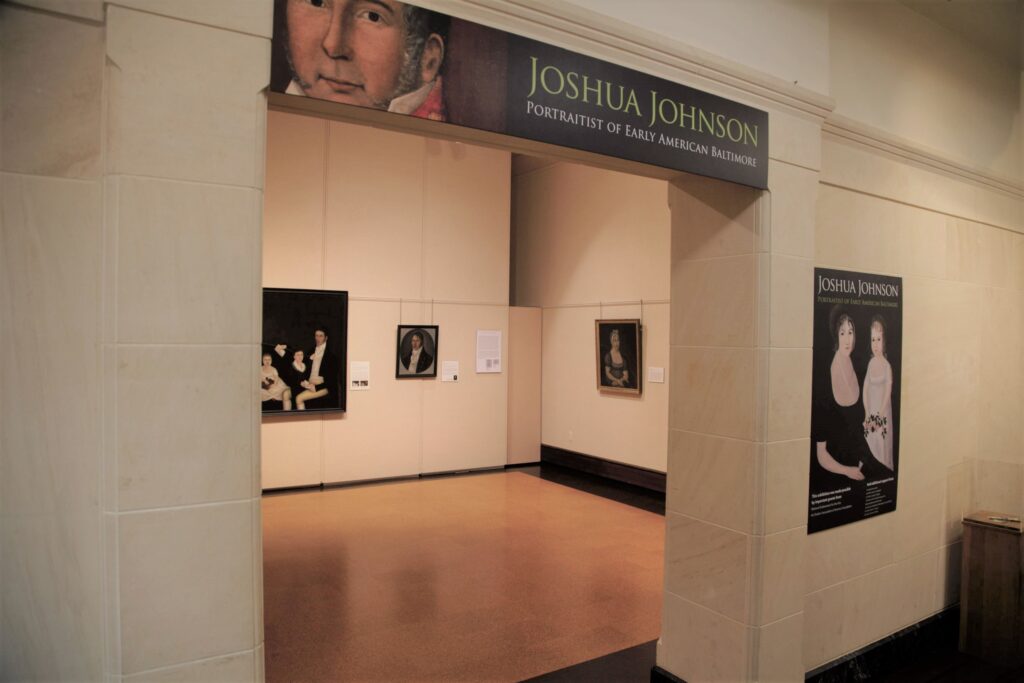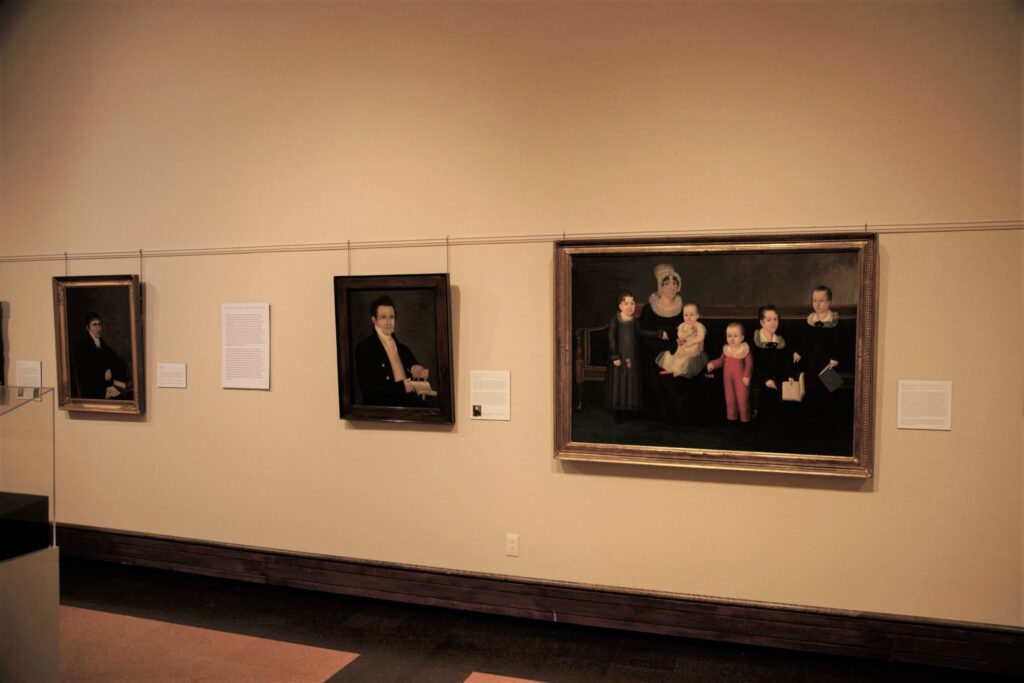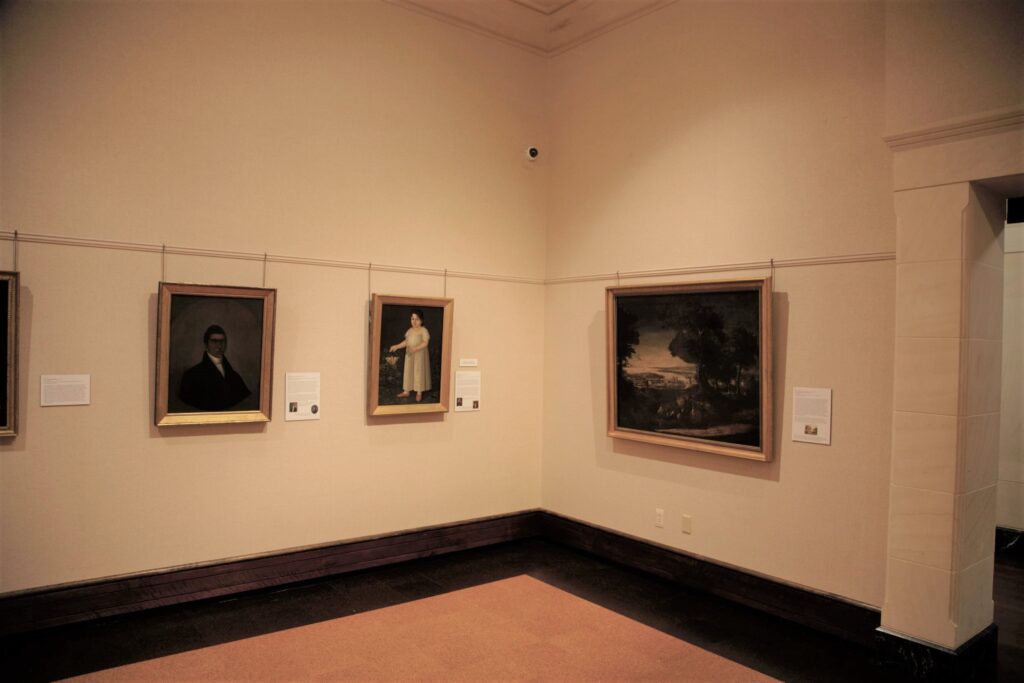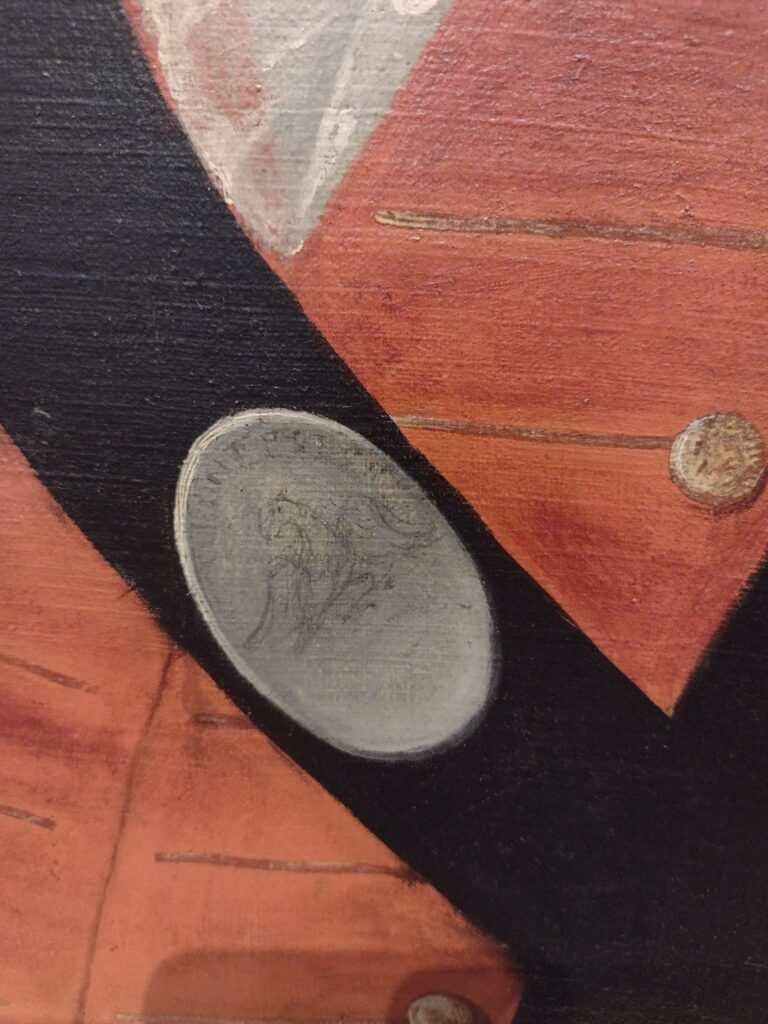Joshua Johnson: Portraitist of Early American Baltimore
Curated by: Daniel Fulco
Exhibition schedule: Washington County Museum of Fine Arts, Hagerstown, MD, April 17, 2021–January 23, 2022
Exhibition catalogue: Daniel Fulco, David Taft Terry, and Mark B. Letzer, Joshua Johnson: Portraitist of Early American Baltimore, exh. cat. Hagerstown: Washington County Museum of Fine Arts, 2021. 106 pp.; color and b/w illus. Cloth: $30.00 (ISBN: 9780914495031)
Joshua Johnson (c. 1763–c. 1824) is one of the few identified artists and artisans of color active in the United States in the early nineteenth century and has long been the subject of research and speculation. The Washington County Museum of Fine Arts presents the exhibition Joshua Johnson: Portraitist of Early American Baltimore with fifteen paintings by Johnson and eleven works by other artists in one large gallery, with a corollary exhibit of primarily American portraits in an adjoining space. Loaned primarily by the Maryland Center for History and Culture (MCHC) and the Baltimore Museum of Art, most of the works by Johnson are regularly displayed at those institutions. Nonetheless, the exhibition affords an excellent opportunity for side-by-side comparisons of works amid tangible reminders of Johnson’s life history provided by the physical presence of the archival records of his enslavement, indenture, and freedom.

Joshua Johnson: Portraitist of Early American Baltimore comes at a moment of reinvestment in Johnson’s biography and artistic output as a consequence of new archival records that add layers to our knowledge of the artist and the complex period in which he lived in the rapidly growing city of Baltimore. Johnson’s life and career complicate traditional notions of artistic production, career building, and relationships among artists in the early Republic. Moreover, his life story asks us to reappraise assumptions about enslavement and life thereafter for African Americans in the mid-Atlantic. Johnson was born to an enslaved woman and a free man, and his father enabled his son’s freedom by purchasing him and then indenturing him to Baltimore blacksmith William Forepaugh.1 Precisely how Johnson became a portrait painter is unknown, although he advertises himself in a Baltimore newspaper as a “self-taught genius” in 1798.2 Several previous scholarly endeavors concerning Johnson rested on assumptions that were later overturned by the discovery in 1996 of Johnson’s 1762 record of sale and 1782 manumission papers. These documents, however, add credibility to some of the oral traditions of the descendants of Johnson’s sitters about the artist that earlier scholarship noted. Previous scholars have thoroughly mined public records and library manuscript holdings for information about the artist, although chance discoveries or new findings may yield more data.3 Johnson remains critical to our understanding of conceptions of race in America and the societal roles African American men could fill in the nineteenth century.
The exhibition’s layout foregrounds Johnson’s life with two small introductory text panels that are placed to the left of the entrance, near a case with the archival volume containing Johnson’s bill of sale and manumission record and their transcriptions. This introduction does not suggest a specific path for visitors, in part because Johnson’s iconic painting The James McCormick Family (c. 1804–5; MCHC) serves as the focal point at the entrance to the exhibition (fig. 1). In this almost seventy-inch-wide painting, rising Baltimore merchant James McCormick and his wife, Rachel, are seated on a black horsehair-covered, Baltimore-made sofa, flanking their three children. The painting speaks to the McCormicks’ desire to record their family, their financial ability to commission the work, and their confidence in Johnson relatively early in his career. The physicality of Johnson’s bill of sale and manumission records—and their proximity to all the works of art in this exhibition—serves as a constant reminder of the artist’s life story and the complexity of his transition from an enslaved person to a well-patronized artist.

In addition to The James McCormick Family, the exhibition includes Johnson’s portrait of the Everette family (fig. 2), another of his handful of family groups that are unusually large for the period. No doubt the size is related to the number of sitters (five and six, respectively), but these portraits can be compared with Charles Willson Peale’s portraits of family groups, such as the Robert Goldsborough family (1789, Philadelphia Museum of Art) and the Edward Lloyd family (1771, Winterthur Museum). These portraits are monumental in scale, suggesting their likely placement in parlors, entryways, or other key large, relatively public spaces in a house. Unlike some other large portraits of slaveholding households, no individuals of color appear in Johnson’s group portraits. Although more work needs to be done on the history of Johnson’s sitters in regard to their keeping of enslaved people, practices of granting manumission, and pursuit of antislavery activities, research to date suggests that while some of his sitters were slaveholders, a core group of his patrons engaged in antislavery endeavors. The exhibition would have ideally included the portrait of Ellin North Moale and her granddaughter (c. 1798–1800; Abby Aldrich Rockefeller Folk Art Museum)—or a reproduction of the work—which would have illustrated Johnson’s ties to the Moale family. John Moale, a justice of the peace and Ellen North Moale’s husband, witnessed Johnson’s 1782 purchase, apprenticeship, and manumission document; the Moales lived in close proximity to Johnson; and the portrait was one of Johnson’s early works. The Moales likely had a significant role in Johnson’s life.

Future scholars might consider whether antislavery activists came to dominate Johnson’s patronage over time and work to more precisely place his life story amid the large number of manumitted individuals in Baltimore.4 Regretfully, the identities of his two known portraits of Black sitters, portraying (possibly) Abner Coker (fig. 3) and Daniel Coker, remain uncertain, as does the nature of Johnson’s connections to the men. More scholarship devoted to excavating the multilayered history of Black Baltimore might permit clarification of his relationship to these sitters. Surviving identified portraits by Johnson signal the diversity of sitters with whom he had close contact—a Catholic bishop, the rising “middling sorts” in his neighborhood, and slaveholders from the surrounding countryside. The sheer range of his patron base suggests that he was a man capable of maneuvering in racially complicated environments in order to find success as an artist.
The juxtaposition of so many of Johnson’s paintings in the exhibition invites speculation about his use of props and visual iconography. Children and occasionally women hold roses but never other types of flowers. Young sitters often grasp strawberries and sometimes point to butterflies. Are the butterflies simply a standard reference to metamorphosis and transformation, or are they a specific regional species? Strawberries, rarely seen in American portraits, were far more ephemeral in the early nineteenth century than they are today—their growing season was short, and their storage and transport limited. Does this circumstance suggest local meanings for these florae, as scholars analyzing Raphaelle Peale’s and Robert S. Duncanson’s still lifes have posited?5 The straightforward interpretations of the imagery in the labels might have been improved by adding closer readings of both the meaning and placement of these iconographic elements. Johnson’s portraits are ripe for interpretation by art historians studying ecology in the early republic and those interested in demonstrating the complexity of place and the visual coding of identity.

The labels are a key component of the installation, as they provide the only guidance for the visitor seeking to interpret the paintings, prints, and documents. As noted, the small but dense introductory text panels do not call attention to themselves. An excellent addition to many object labels and text panels are the photographic reproductions that refer to additional paintings not included in the exhibition. New interpretations of the pictorial sources for Johnson’s portrait of Archbishop John Carroll, for example, are amplified by images and accompanying text that allow for close comparison. Nevertheless, the lengthy labels are, quite literally, a “book on the wall,” taken almost verbatim from the catalog entries, and unusually long (averaging about 300 words). This reviewer yearned for more labels that actively engage the viewer with the works of art to enrich an understanding of Johnson, his oeuvre, and his milieu. Johnson’s painting of an unidentified girl titled In the Garden (c. 1805; Baltimore Museum of Art) is one of only a few examples where the label suggests that viewers focus on details in the work rather than prioritizing biographical information.6 Additionally, the labels could have explained issues of materiality pertinent to Johnson’s portraits. For example, several paintings, such as Charles Burnett (c. 1812, MCHC), retain elements of graphite drawing that may have intrigued viewers interested in processes or materials ( 4).7 If the labels had drawn attention to this feature or noted Johnson’s unusually thin paint application, the texts may have helped viewers develop the skills of close looking that they could then use in other galleries and beyond the museum’s walls.
One valuable addition to the exhibition is a group of portraits by other mid-Atlantic artists that suggest how Johnson might have learned to paint portraits that met early American standards of depiction. Although the inclusion of comparative paintings is useful to show the types of works Johnson may have seen in Baltimore-area homes, particularly as he described himself as a “self-taught genius,” this avenue of research and analysis tends to veer towards formal analysis. Several labels point to Johnson’s use of props such as books, which, particularly for women, were common in colonial and early national portraits. Asking viewers to compare the mostly domestic props that women held versus the business-centered props, such as ledgers, that were included in men’s images might have called attention to the gendered assumptions that portraits reinforced, taking analysis to a higher level.
The exhibition provides the Washington County Museum of Fine Arts, a regional institution, with a tremendous opportunity to expand and diversify its audience, highlight the two Johnson paintings in the museum’s collection, and—hopefully—enable the discovery of additional paintings and documents related to the artist. The exhibition is accompanied by a 106-page catalogue that synthesizes previous scholarship, providing readers with up-to-date information on Johnson as well as color illustrations of the works in the exhibition and other related images.
Cite this article: Anne Verplanck, review of Joshua Johnson: Portraitist of Early American Baltimore, Washington County Museum of Fine Arts, Panorama: Journal of the Association of Historians of American Art 7, no. 2 (Fall 2021), https://doi.org/10.24926/24716839.12812.
PDF: Verplanck, review of Joshua Johnson
Notes
The author wishes to thank Daniel Fulco, Sarah J. Hall, Kellie Mele, and Jillian MacMaster at the Washington County Museum of Fine Arts for providing information and observations about the exhibition. She is indebted to scholars Stiles Tuttle Colwill and Linda Crocker Simmons for their insights about the exhibition and Johnson. The editors of Panorama provided helpful critiques that strengthened this review.
- Scholars have assumed the indentured position allowed Joshua Johnson’s father to fund the purchase of his son from owner William Wheeler Sr. in 1764. Jennifer Bryan and Robert Torchia, “The Mysterious Portraitist Joshua Johnson,” Archives of American Art Journal 36, no. 2 (1996): 2–7. ↵
- Baltimore Intelligencer, December 19, 1798. ↵
- Key works of Johnson scholarship include J. Hall Pleasants, “An Early Baltimore Negro Portrait Painter: Joshua Johnson,” Walpole Society Notebook (1939): 37–48; J. Hall Pleasants, “Joshua Johnson, the First American Negro Portrait Painter,” Maryland Historical Magazine 38 (1942): 121–49; Carolyn Weekley and Stiles Tuttle Colwill, with Leroy Graham and Mary Ellen Hayward, Joshua Johnson: Freeman and Early American Portrait Painter (Williamsburg: Colonial Williamsburg and Maryland Historical Society, 1987); Mary Lynn Perry, “Joshua Johnson: His Historical Context and His Art” (MA thesis, George Washington University, 1983); Toby Maria Chieffo, “Joshua Johnson Revisited: Filling the Lacunae” (MA thesis, College of William and Mary, 1995); Bryan and Torchia, “Mysterious Portraitist Joshua Johnson.” ↵
- On self-purchase, delayed manumission, and the number of free Blacks in Baltimore by 1830, see T. Stephen Whitman, The Price of Freedom: Slavery and Manumission in Baltimore and Early National Maryland (Lexington: University Press of Kentucky, 1997), esp. 1, 13, 36. ↵
- For a discussion of fruit in mid-Atlantic paintings, see Shana Klein, “Cultivating Fruit and Equality,” American Art 29, no. 2 (June 2015): 64–85; Brandon Brame Fortune, “A Delicate Balance: Raphaelle Peale’s Still-Life Paintings and the Ideal of Temperance,” in The Peale Family: Creation of a Legacy, 1770–1870, ed. Lillian B. Miller (New York: Abbeville Press, 1996), 134–49; Phoebe Lloyd, “Raphaelle Peale’s Anne-Arundel Still Life: A Local Treasure Lost and Found,” Maryland Historical Magazine 87 (Spring 1992): 1–9. ↵
- Labels intended for children were planned but were not in place in the galleries during my July 2021 site visit. Kellie Mele, Director of Education, WCMFA, to the author, July 22, 2021. ↵
- Sian Jones, “Johnson’s Materials and His Techniques,” in Weekley and Colwill, Joshua Johnson, 65–67. ↵
About the Author(s): Anne Verplanck is Associate Professor of American Studies and Public Heritage at Pennsylvania State University, Harrisburg

